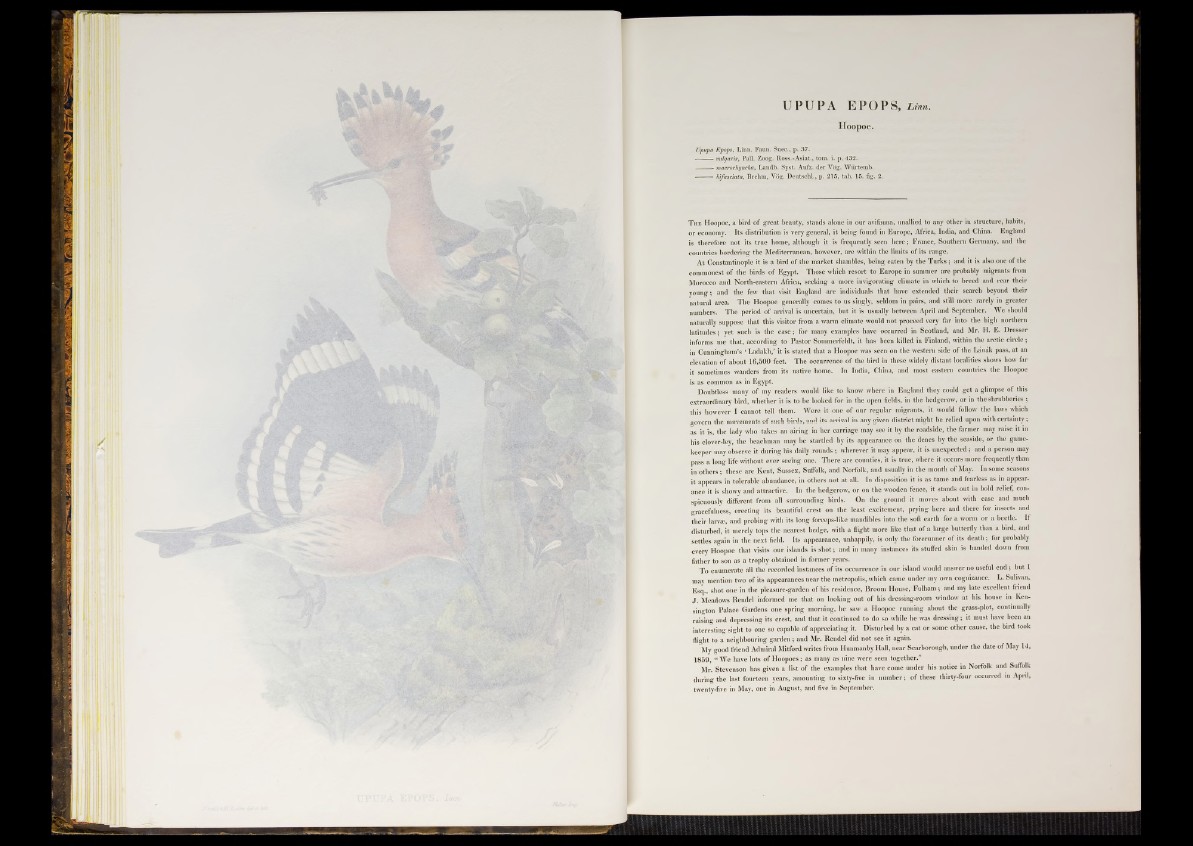
Ik
UPUPA EPOPS, L inn.
Hoopoe.
Upupa Epops, Linn. Faun. Suec., p. 37.
vulgaris, Pall. Zoog. Ross.-Asiat., tom. i. p. 432.
macrorhyncha, Landb. Syst. Aufz. der Vög. Würtemb.
bifasciata, Brehm, Vög. Deutschl., p. 215, tab. 15. fig. 2.
T h e Hoopoe, a bird o f great beauty, stands alone in our avifauna, unallied to any other in structure, habits,
or economy. Its distribution is very general, it being found in Europe, Africa, India, and China. England
is therefore not its true home, although it is frequently seen h e re ; France, Southern Germany, and the
countries bordering the Mediterranean, however, are within the limits of its range.
At Constantinople it is a bird of the market shambles, being eaten by the T u rk s ; and it is also one o f the
commonest of the birds o f Egypt. Those which resort to Europe in summer are probably migrants from
Morocco and North-eastern Africa, seeking a more invigorating climate in which to breed and rear their
young; and the few that visit England are individuals that have extended their search beyond their
natural area. The Hoopoe generally comes to us singly, seldom in pairs, and still more rarely in greater
numbers. The period of arrival is uncertain, but it is usually between April and September. We should
naturally suppose that this visitor from a warm climate would not proceed very far into the high northern
latitudes; yet such is the case; for many examples have occurred in Scotland, and Mr. H. E. Dresser
informs me that, according to Pastor Sommerfeldt, it has been killed in Finland, within the arctic circle;
in Cunningham’s ‘ Ladakh,’ it is stated that a Hoopoe was seen on the western side of the Lanak pass, at an
elevation of about 16,500 feet. The occurrence of the bird in these widely distant localities shows how far
it sometimes wanders from its native home. In India, China, and most eastern countries the Hoopoe
is as common as in Egypt.
Doubtless many of my readers would like to know where in England they could get a glimpse of this
extraordinary bird, whether it is to be looked for in the open fields, in the hedgerow, or in the shrubberies ;
this however I cannot tell them. Were it one of our regular migrants, it would follow the laws which
govern the movements of such birds, and its arrival in any given district might be relied upon with certainty;
as it is, the lady who takes an airing in her carriage may see it by the roadside, the farmer may raise it in
his clover-ley, the beachman may be startled by its appearance on the denes by the seaside, or the gamekeeper
may observe it during his daily rounds ; wherever it may appear, it is unexpected; and a person may
pass a long life without ever seeing one. There are counties, it is true, where it occurs more frequently than
in o th ers ; these are Kent, Sussex, Suffolk, and Norfolk, and usually in the month of May. In some seasons
it appears in tolerable abundance, in others not at all. In disposition it is as tame and fearless as in appearance
it is showy and attractive. In the hedgerow, or on the wooden fence, it stands out in bold relief, conspicuously
different from all surrounding birds. On the ground it moves about with ease and much
«»■racefulness, erecting its beautiful crest on the least excitement, prying here and there for insects and
their larvae, and probing with its long forceps-like mandibles into the soft earth for a worm or a beetle. If
disturbed, it merely tops the nearest hedge, with a flight more like that of a large butterfly than a bird, and
settles again in the next field. Its appearance, unhappily, is only the forerunner o f its d eath ; for probably
every Hoopoe that visits our islands is sh o t; and in many instances its stuffed skin is handed down from
father to son as a trophy obtained in former years.
To enumerate all the recorded instances of its occurrence in our island would answer no useful e n d ; but I
may mention two of its appearances near the metropolis, which came under my own cognizance. L. Sulivan,.
Esq., shot one in the pleasure-garden of his residence, Broom House, Fulham; and my late excellent friend
J . Meadows Rendel informed me that on looking out of his dressing-room window at his house in Kensington
Palace Gardens one spring morning, he saw a Hoopoe running about the grass-plot, continually
raising and depressing its crest, and that it continued to do so while he was dressing; it must have been an
interesting sight to one so capable of appreciating it. Disturbed by a cat or some other cause, the bird took
flight to a neighbouring garden; and Mr. Rendel did not see it again.
My good friend Admiral Mitford writes from Hunmanby Hall, near Scarborough, under the date o f May 14,
1859, “ We have lots of Hoopoes; as many as nine were seen together.”
Mr. Stevenson has given a list of the examples that have come under his notice in Norfolk and Suffolk
during the last fourteen years, amounting to sixty-five in number; of these thirty-four occurred in April,
twenty-five in May, one in August, and five in September.